Hair iron with dimpled face plates and method of use in styling hair
a technology of face plates and hair irons, which is applied in the field of curling irons, can solve the problems of muddied color, surface bonding of pigment in coloring, and non-uniform distribution of pigment, so as to prolong the integrity of hair color, and reduce the effect of refraction
- Summary
- Abstract
- Description
- Claims
- Application Information
AI Technical Summary
Benefits of technology
Problems solved by technology
Method used
Image
Examples
Embodiment Construction
[0023]Referring to FIG. 1, a hair iron in accordance with an embodiment of the invention is shown comprising a lower body 10 and an upper body 12 joined by hinge 14 at their rear ends so that they can meet flexibly while facing each other. A lower heating plate 16 is installed at the front area of the lower body 10 and an upper heating plate 18 (FIG. 3) is installed at the front area of the upper body 12.
[0024]Referring to FIGS. 2 and 3 (FIG. 3 is in inverted perspective to FIG. 2), the hinge 14 includes lower and upper mating clevises, respectively 20 and 22, secured by a clevis pin 24a and 24b. A pair of caps 26 and 28 aesthetically covers the hinge. A spring 30 secured within lower and upper telescoping semispherical plastic housings, respectively 32 and 34, is located internally adjacent the hinge 14, and biases the hair iron to an open position.
[0025]Electrical wiring 36 extends from an encasement 38 at the rear end of the hair iron. The encasement includes a rotatable control ...
PUM
 Login to View More
Login to View More Abstract
Description
Claims
Application Information
 Login to View More
Login to View More - R&D
- Intellectual Property
- Life Sciences
- Materials
- Tech Scout
- Unparalleled Data Quality
- Higher Quality Content
- 60% Fewer Hallucinations
Browse by: Latest US Patents, China's latest patents, Technical Efficacy Thesaurus, Application Domain, Technology Topic, Popular Technical Reports.
© 2025 PatSnap. All rights reserved.Legal|Privacy policy|Modern Slavery Act Transparency Statement|Sitemap|About US| Contact US: help@patsnap.com



